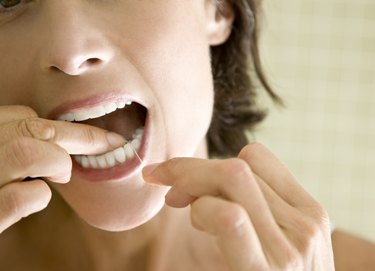

The Refresh is helping you freshen up on your oral-care knowledge and upgrade your dental-hygiene routine.
If you've managed to make flossing a part of your daily dental care routine, kudos. Only a mere 16 percent of adults floss once a day, according to a survey by the American Dental Association (ADA).
But threading a piece of dental string through your teeth is only half the battle. What you do with the floss is what really matters.
Video of the Day
Video of the Day
Yep, there's a right way and a wrong way to floss for healthy teeth and gums. And odds are you're in the latter camp.
That's because most people tend to floss up and down. While this feels like the most intuitive way to get rid of gunk between your teeth, this method misses a lot of muck. "Simply going up and down does not remove the plaque hiding by the gumline," says Zahra Omar, DDS.
So, what's the correct way to floss? Read on to learn about the proper flossing technique for optimal oral health.
The Proper Way to Floss
Even if you floss daily, you might be missing certain places. Flossing up and down only removes some of the stuff between your teeth, but it neglects the sides of your teeth and the area below the gumline where plaque can accumulate.
Teeth curve into the gums, so when you floss, you need to follow the contour of the tooth to remove plaque, Dr. Omar says. The best way to get into those hard-to-reach spaces is by making a C shape with your floss. This enables you to slide the string around the sides of your teeth and near your gumline.
For flawless flossing technique, follow this step-by-step guide from the ADA.
- Break off about 18 inches of floss and wind most of it around one of your middle fingers. Wind the remaining floss around the same finger of the opposite hand. This finger will take up the floss as it becomes dirty.
- Hold the floss tightly between your thumbs and forefingers.
- Guide the floss between your teeth using a gentle rubbing motion. Never snap the floss into the gums.
- When the floss reaches the gumline, curve it into a C shape against one tooth. Gently slide it into the space between the gum and the tooth.
- Hold the floss tightly against the tooth. Gently rub the side of the tooth, moving the floss away from the gum with up and down motions. Repeat this method on the rest of your teeth. Don't forget the back side of the teeth in the back of your mouth.
Tip
For the best results, floss before you brush. This will help dislodge food particles buried between your teeth, so they can be scrubbed clean by the brush. This also enables the fluoride in toothpaste to reach areas between your teeth more easily.
Consider a Water Flosser if You’re Over 35
"For most adults over 35, I recommend a water flosser in addition to [regular] floss, so that you really remove all the gunk hiding between your teeth," Dr. Omar says.
Here's why: As we age, we start to lose alveolar bone (the part of the jaw that holds the teeth), she says. That means we need to pay special attention to our dental care as we grow older to offset this age-related bone loss.
Water flossing can serve as a preventative measure. But remember: A water flosser should be used as an addition to (not instead of) regular flossing.
Try One of These Water Flossers
- Waterpik Aquarius ($66.23, Amazon)
- Waterpik Cordless Express ($35.97, Walmart)
Side Effects of Improper Flossing
When you skip certain tooth surfaces, you leave your mouth vulnerable to dental problems. Here's what could happen if you don't floss properly.
1. It Can Lead to Gum Disease
"Improper flossing allows plaque accumulation, and this in turn causes gums to be inflamed," Dr. Omar says. Over time, this inflammation can result in gum disease as your body fights against the plaque and bacteria by the gumline.
What's more, plaque can calcify and harden to create calculus (also known as tartar). Again, your body will produce an inflammatory response to combat calculus, which can cause the gum and bone to recede and give rise to periodontal disease, Dr. Omar says.
2. It Can Cause Cavities
When you don't floss correctly, you're also allowing bacteria to feed on plaque, which releases acid that can cause decay, Dr. Omar says. This acid is what eats away at the tooth structure and causes cavities.
Related Reading
Is this an emergency? If you are experiencing serious medical symptoms, please see the National Library of Medicine’s list of signs you need emergency medical attention or call 911.